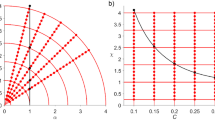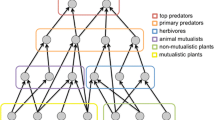Abstract
Four models of network structure are combined with models of bioenergetic dynamics to study the role of food web topology and nonlinear dynamics on species coexistence in complex ecological networks. Network models range from the highly structured niche model to loosely constrained energetically feasible random networks. Bioenergetic models differ in how they represent primary production, functional responses, and consumption by generalists. Network structure weakly influenced the ability of species to coexist. Species persistence is strongly affected by functional responses and generalists’ consumption rates but weakly affected by models and amounts of primary production. Despite these generalities, specific mechanisms that determine persistence under one dynamical regime, such as top-down control by consumers, may play an insignificant role under different dynamical conditions. Future research is needed to strengthen the weak empirical basis for various functional forms and parameter values that strongly influence whether species can coexist in complex food webs.


Similar content being viewed by others
References
Amaral LAN, Meyer M (1999) Environmental changes, coextinction and patterns in the fossil record. Phys Rev Lett 82:652–655
Arditi R, Michalski JJ (1996) Nonlinear food web models and their responses to increased basal productivity. In: Polis GA, Winemiller KO (eds) Food webs: integration of patterns and dynamics. Chapman and Hall, New York, pp 122–133
Bascompte J, Melian CJ (2005) Simple trophic modules for complex food webs. Ecology 86:2868–2873
Beckerman AP, Petchey OL, Warren PH (2006) Foraging biology predicts food web complexity. Proc Natl Acad Sci USA 103:13745–13749
Beddington JR (1975) Mutual Interference between parasites or predators and its effect on searching efficiency. J Anim Ecol 44:331–340
Borer ET, Anderson K, Blanchette CA, Broitman B, Cooper SD, Halpern BS (2002) Topological approaches to food web analyses: a few modifications may improve our insights. Oikos 99:397–401
Brose U, Berlow EL, Martinez ND (2005) Scaling up keystone effects from simple to complex ecological networks. Ecol Lett 8:1317–1325
Brose U, Jonsson T, Berlow EL, Warren P, Banasek-Richter C, Bersier LF, Blanchard JL, Brey T, Carpenter SR, Blandenier MFC, Cushing L, Dawah HA, Dell T, Edwards F, Harper-Smith S, Jacob U, Ledger ME, Martinez ND, Memmott J, Mintenbeck K, Pinnegar JK, Rall BC, Rayner TS, Reuman DC, Ruess L, Ulrich W, Williams RJ, Woodward G, Cohen JE (2006a) Consumer-resource body-size relationships in natural food webs. Ecology 87:2411–2417
Brose U, Williams RJ, Martinez ND (2006b) Allometric scaling enhances stability in complex food webs. Ecol Lett 9:1228–1236
Brown JH, Gillooly JF, Allen AP, Savage VM, West GB (2004) Toward a metabolic theory of ecology. Ecology 85:1771–1789
Caldarelli G, Higgs PG, McKane AJ (1998) Modelling coevolution in multispecies communities. J Theor Biol 193:345–358
Camacho J, Sole RV (2000) Extinction and taxonomy in a trophic model of coevolution. Phys Rev E 62:1119
Camacho J, Guimera R, Amaral LAN (2002) Robust patterns in food web structure. Phys Rev Lett 88:228102
Cattin M-F, Bersier L-F, Banasek-Richter C, Baltensperger R, Gabriel J-P (2004) Phylogenetic constraints and adaptation explain food-web structure. Nature 427:835–839
Chesson J (1983) The estimation and analysis of preference and its relationship to foraging models. Ecology 64:1297–1304
Cohen JE, Briand F, Newman CM (1990) Community food webs: data and theory. Springer, Berlin
Cohen JE, Beaver RA, Cousins SH, DeAngelis DL, Goldwasser L, Heong KL, Holt RD, Kohn AJ, Lawton JH, Martinez N, O’Malley R, Page LM, Patten BC, Pimm SL, Polis GA, Rejm nek M, Schoener TW, Schoely K, Sprules WG, Teal JM, Ulanowicz RE, Warren PH, Wilbur HM, Yodzis P (1993) Improving food webs. Ecology 74:252–258
DeAngelis DL, Goldstein RA, Oneill RV (1975) Model for trophic interaction. Ecology 56:881–892
Drossel B, Higgs PG, McKane AJ (2001) The influence of predator–prey population dynamics on the long-term evolution of food web structure. J Theor Biol 208:91–107
Drossel B, McKane AJ, Quince C (2004) The impact of nonlinear functional responses on the long-term evolution of food web structure. J Theor Biol 229:539–548
Dunne JA (2006) The network structure of food webs. In: Pascual M, Dunne JA (eds) Ecological networks: linking structure to dynamics in food webs. Oxford University Press, New York
Dunne JA, Williams RJ, Martinez ND (2004) Network structure and robustness of marine food webs. Mar Ecol Prog Ser 273:291–302
Elton CS (1958) Ecology of invasions by animals and plants. Chapman & Hall, London
Emmerson M, Yearsley JM (2004) Weak interactions, omnivory and emergent food-web properties. Proc R Soc Lond B Biol Sci 271:397–405
Enquist BJ, West GB, Charnov EL, Brown JH (1999) Allometric scaling of production and life-history variation in vascular plants. Nature 401:907–911
Erdos P, Renyi A (1959) On random graphs I. Publ Math (Debr) 6:290–297
Ernest SKM, Enquist BJ, Brown JH, Charnov EL, Gillooly JF, Savage VM, White EP, Smith FA, Hadly EA, Haskell JP, Lyons SK, Maurer BA, Niklas KJ, Tiffney B (2003) Thermodynamic and metabolic effects on the scaling of production and population energy use. Ecol Lett 6:990–995
Fagan WF (1997) Omnivory as a stabilizing feature of natural communities. Am Nat 150:554–567
Fussman GF, Blasius B (2005) Community response to enrichment is highly sensitive to model structure. Biol Lett 1:9–12
Garcia-Domingo JL, Saldana J (2007) Food-web complexity emerging from ecological dynamics on adaptive networks. J Theor Biol 247:819–826
Gentleman W, Leising A, Frost B, Strom S, Musrray J (2003) Functional responses for zooplankton feeding on multiple resources: a review of assumptions and biological dynamics. Deep-Sea Res II 50:2847–2875
Holling CS (1959) The components of predation as revealed by a study of small-mammal predation of the European pine sawfly. Can Entomol 91:293–320
Hutchinson GE (1959) Homage to Santa Rosalia or why are there so many kinds of animals? Am Nat 93:145–159
Jeschke JM, Kopp M, Tollrian R (2002) Predator functional responses: discriminating between handling and digesting prey. Ecol Monogr 72:95–112
Kondoh M (2003) Foraging adaptation and the relationship between food-web complexity and stability. Science 299:1388–1391
Loeuille N, Loreau M (2005) Evolutionary emergence of size-structured food webs. Proc Natl Acad Sci USA 102:5761–5766
Martinez ND, Williams RJ, Dunne JA (2006) Diversity, complexity, and persistence in large model ecosystems. In: Pascual M, Dunne JA (eds) Ecological networks: linking structure to dynamics in food webs. Oxford University Press, New York
May RM (1972) Will a large complex system be stable? Nature 238:413–414
McCann KS (2000) The diversity–stability debate. Nature 405:228–233
McCann K, Hastings A (1997) Re-evaluating the omnivory–stability relationship in food webs. Proc R Soc Lond B Biol Sci 264:1249–1254
McCann K, Hastings A, Huxel GR (1998) Weak trophic interactions and the balance of nature. Nature 395:794–798
Milo R, Shen-Orr S, Itzkovitz S, Kashtan N, Chklovskii D, Alon U (2002) Network motifs: simple building blocks of complex networks. Science 298:824–827
Montoya JM, Sole RV (2003) Topological properties of food webs: from real data to community assembly models. Oikos 102:614–622
Murdoch WW (1973) The functional response of predators. J Appl Ecol 10:335–342
Nachman G (2006) A functional response model of a predator population foraging in a patchy environment. J Anim Ecol 75:948–958
Neutel AM, Heesterbeek JAP, de Ruiter PC (2002) Stability in real food webs: weak links in long loops. Science 296:1120–1123
Pimm SL (1984) The complexity and stability of ecosystems. Nature 307:321–326
Pimm SL, Lawton JH (1977) Number of trophic levels in ecological communities. Nature 268:329–331
Pimm SL, Lawton JH (1978) Feeding on more than one trophic level. Nature 275:542–544
Post DM (2002) The long and short of food-chain length. Trends Ecol Evol 17:269–277
Post DM, Conners ME, Goldberg DS (2000) Prey preference by a top predator and the stability of linked food chains. Ecology 81:8–14
Real LA (1977) The kinetics of functional response. Am Nat 111:289–300
Real LA (1978) Ecological determinants of functional response. Ecology 60:481–485
Rossberg AG, Matsuda H, Amemiya T, Itoh K (2006a) Food webs: experts consuming families of experts. J Theor Biol 241:552–563
Rossberg AG, Matsuda H, Amemiya T, Itoh K (2006b) Some properties of the speciation model for food web structure – mechanisms for degree distribution. J Theor Biol 238:401–415
Skalski GT, Gilliam JF (2001) Functional responses with predator interference: viable alternatives to the Holling Type II model. Ecology 82:3083–3092
Stouffer DB, Camacho J, Guimera R, Ng CA, Amaral LAN (2005) Quantitative patterns in the structure of model and empirical food webs. Ecology 86:1301–1311
Stouffer DB, Camacho J, Jiang W, Amaral LAN (2007) Evidence for the existence of a robust pattern of prey selection in food webs. Proc R Soc Lond B Biol Sci 274:1931–1940
Thompson RM, Hemberg M, Starzomski BM, Shurin JB (2007) Trophic levels and trophic tangles: the prevalence of omnivory in real food webs. Ecology 88:612–617
Uchida S, Drossel B (2007) Relation between complexity and stability in food webs with adaptive behavior. J Theor Biol 247:713–722
Vandermeer J (2006) Omnivory and the stability of food webs. J Theor Biol 238:497–504
Williams RJ, Martinez ND (2000) Simple rules yield complex food webs. Nature 404:180–183
Williams RJ, Martinez ND (2004a) Limits to trophic levels and omnivory in complex food webs: theory and data. Am Nat 163:458–468
Williams RJ, Martinez ND (2004b) Stabilization of chaotic and non-permanent food-web dynamics. Eur Phys J B 38:297–303
Williams RJ, Berlow EL, Dunne JA, Barabasi AL, Martinez ND (2002) Two degrees of separation in complex food webs. Proc Natl Acad Sci USA 99:12913–12916
Williams RJ, Brose U, Martinez ND (2007) Homage to Yodzis and Innes 1992: scaling up feeding-based population dynamics to complex ecological networks. In: Rooney N, McCann KS, Noakes DIG (eds) From energetics to ecosystems: the dynamics and structure of ecological systems. Springer, New York
Yodzis P (1981) The stability of real ecosystems. Nature 289:674–676
Yodzis P, Innes S (1992) Body size and consumer–resource dynamics. Am Nat 139:1151–1175
Yoshida K (2003) Dynamics of evolutionary patterns of clades in a food web system model. Ecol Res 18:625–637
Acknowledgments
I would like to thank Neo Martinez for many useful discussions and comments on an early version of this manuscript.
Author information
Authors and Affiliations
Corresponding author
Electronic supplementary material
Below is the link to the electronic supplementary material.
Rights and permissions
About this article
Cite this article
Williams, R.J. Effects of network and dynamical model structure on species persistence in large model food webs. Theor Ecol 1, 141–151 (2008). https://doi.org/10.1007/s12080-008-0013-5
Received:
Accepted:
Published:
Issue Date:
DOI: https://doi.org/10.1007/s12080-008-0013-5




